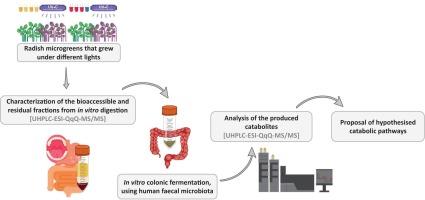Digestion and gut microbiota catabolism of (poly)phenols from radish microgreens grown under different lights
IF 9.8
1区 农林科学
Q1 CHEMISTRY, APPLIED
引用次数: 0
Abstract
Radish microgreens contain (poly)phenols, whose fate after gastrointestinal digestion remains largely unknown. This study investigated the in vitro digestion and colonic fermentation of two radish microgreen (Raphanus sativus L.) cultivars, Daikon and Red Rambo, grown under different lights in vertical farming, exploring how cultivar and light influence (poly)phenol catabolism. After digestion, most (poly)phenols remained in the residual fraction, which was subjected to microbial fermentation, resulting in a large set of catabolites. Cultivar differences outweighed the effects of light treatments, as Red Rambo retained twice the (poly)phenols of Daikon, influencing fermentation outcomes. 4′-Hydroxy-3′,5′-dimethoxycinnamoyl malate and sinapoyl choline dominated both cultivars, while flavonoids and anthocyanins in Red Rambo contributed with further complexity. Microbiota-derived catabolites included low molecular weight compounds such as 3-(3′,4′-dihydroxyphenyl)propanoic and 3-(4′-hydroxy-3′-methoxyphenyl)propanoic acids, along with 4′-hydroxy-3′,5′-dimethoxycinnamic, 4′-hydroxy-3′-methoxycinnamic, 4′-hydroxycinnamic, and 3-(4′-hydroxyphenyl)propanoic acids. Hypothesised catabolic pathways were outlined, with 4′-hydroxy-3′,5′-dimethoxycinnamoyl malate and sinapoyl choline microbial catabolism being outlined for the first time.


不同光照下萝卜微绿中多酚的消化和肠道微生物分解代谢
萝卜的微蔬菜含有(多)酚,其在胃肠道消化后的命运仍然很大程度上未知。本研究研究了竖直栽培下不同光照条件下萝卜微绿(Raphanus sativus L.)品种白萝卜(Daikon)和红兰博(Red Rambo)的体外消化和结肠发酵,探讨了品种和光照对(多)酚分解代谢的影响。消化后,大部分(多)酚残留在残渣中,经微生物发酵,产生大量分解产物。品种差异超过了光处理的影响,因为红兰博保留的(多)酚是白萝卜的两倍,影响了发酵结果。4 ' -羟基-3 ',5 ' -二甲氧基肉桂酰苹果酸酯和sinapoyl胆碱在这两个品种中占主导地位,而黄酮类和花青素在红兰博中发挥了进一步的作用。微生物衍生的分解代谢物包括低分子量化合物,如3-(3 ',4 ' -二羟基苯基)propanic和3-(4 ' -羟基-3 ' -甲氧基苯基)propanic酸,以及4 ' -羟基-3 ',5 ' -二甲氧基肉桂,4 ' -羟基-3 ' -甲氧基肉桂,4 ' -羟基肉桂和3-(4 ' -羟基苯基)propanic酸。提出了几种可能的分解代谢途径,其中首次提出了4′-羟基-3′、5′-二甲氧基肉桂酰苹果酸酯和sinapoyl胆碱的微生物分解代谢。
本文章由计算机程序翻译,如有差异,请以英文原文为准。
求助全文
约1分钟内获得全文
求助全文
来源期刊

Food Chemistry
工程技术-食品科技
CiteScore
16.30
自引率
10.20%
发文量
3130
审稿时长
122 days
期刊介绍:
Food Chemistry publishes original research papers dealing with the advancement of the chemistry and biochemistry of foods or the analytical methods/ approach used. All papers should focus on the novelty of the research carried out.
 求助内容:
求助内容: 应助结果提醒方式:
应助结果提醒方式:


